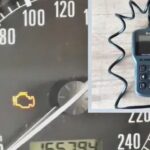Dealing with car troubles can be frustrating, especially when your “Service Engine Soon” light pops up. For many car owners, the question arises: Can Obd Scanner tools actually help figure out what’s wrong? This story is about how a DIYer tackled a stalling issue with a 2000 Nissan Altima and the role an OBD2 scanner played in the process – with a few bumps along the road.
It started when the Nissan Altima began stalling, particularly when accelerating or under load. Despite stalling, the engine would restart, only to stall again soon after. The illuminated “Service Engine Soon” light was a clear sign something was amiss. Initially, a friend used an OTC scanner to check for error codes. However, after connecting the scanner, the car strangely refused to start at all. Cranking but not starting, and no error codes were retrievable at that point.
After letting the car sit overnight, surprisingly, it started again the next morning. Basic maintenance steps were taken: a fuel filter and oil change. The car seemed okay for a day, but then the stalling issue returned while the owner’s daughter was driving. This prompted further investigation and the decision to invest in a personal OBD2 scanner. An Ancel 410 scanner was purchased for $73.00.
While waiting for the new scanner to arrive, online research and YouTube videos were consulted for potential causes of the stalling. A significant discovery was made: a vacuum hose, chewed by rodents, was found in the engine bay. This leaky hose appeared to be the culprit behind the stalling issue and likely triggered the “Service Engine Soon” light. Replacing the damaged hose seemed to resolve the stalling problem, and the car ran smoothly during test drives. However, the “Service Engine Soon” light remained on, indicating stored error codes.
Once the car was running again, the friend returned with his OTC OBD scanner to finally read the error codes. This time, the scanner successfully retrieved several codes: P0100 (Mass Air Flow Circuit Malfunction), P0505 (Idle Air Control System Malfunction), P0325 (Knock Sensor 1 Circuit Malfunction), P1490 (Vacuum Cut Valve Bypass Valve Malfunction), P0446 (Evaporative Emission Control System Vent Control Circuit Malfunction), and P0464 (Fuel Level Sensor Circuit Intermittent).
Interestingly, connecting the OBD scanner again caused the car to not start – the same issue experienced before. It seemed the scanner was somehow interfering with the car’s system. Further online research pointed to a possible explanation: in some cases, OBD scanners can disrupt the Engine Control Module (ECM), requiring a hard reset.
The solution for this ECM issue was found to be a hard reset by disconnecting both battery terminals and briefly connecting them together (away from the battery) for about 10 seconds. This process discharges capacitors in the ECM. After performing this hard reset, the car started again.
This experience highlights a few key points regarding can OBD scanner tools be helpful:
- OBD scanners can read error codes: They are essential tools for accessing diagnostic information stored by your car’s computer when the “Check Engine” or “Service Engine Soon” light is on.
- Error codes provide clues, not definitive answers: The retrieved codes offered starting points for diagnosis, but further investigation (like finding the vacuum leak) was crucial to pinpoint the actual problem.
- Scanner compatibility and potential issues: While generally safe, in rare cases, scanners can potentially interfere with the car’s electronics, as experienced in this story. This might be due to scanner compatibility issues or pre-existing electrical problems in the vehicle.
- DIY diagnostics with caution: Using an OBD scanner empowers car owners to perform basic diagnostics themselves, saving time and money. However, it’s important to proceed with caution, research potential issues thoroughly, and understand the limitations of DIY repair.
- Hard reset as a troubleshooting step: In situations where the ECM might be glitched or unresponsive, a hard reset by disconnecting the battery can sometimes resolve the issue.
Ultimately, the OBD scanner, even with a temporary setback, played a vital role in diagnosing the Nissan Altima’s problems. It helped identify error codes that, combined with careful observation and research, led to the discovery and repair of the vacuum leak. This story demonstrates that while can OBD scanner be powerful diagnostic aids, they are just one tool in the car troubleshooting process, requiring a combination of technical understanding and problem-solving skills.

